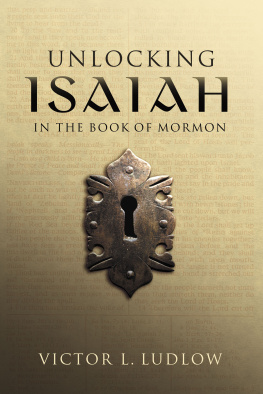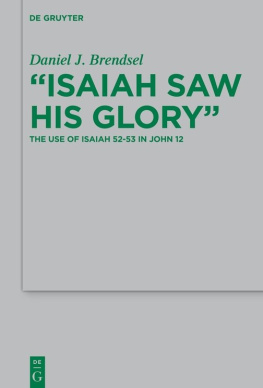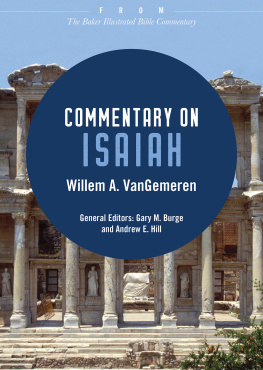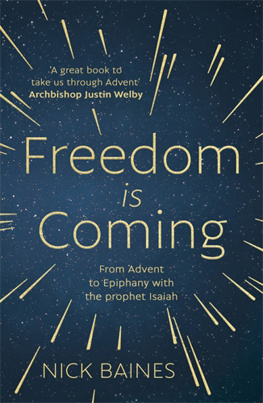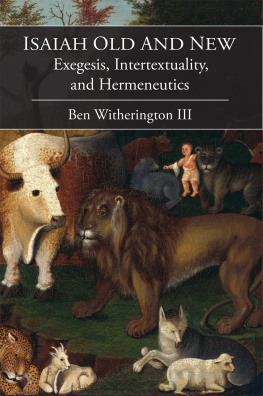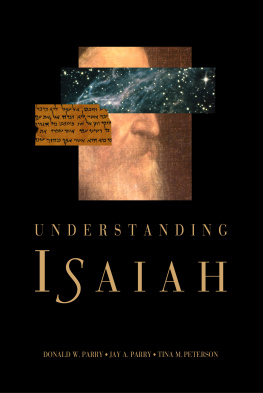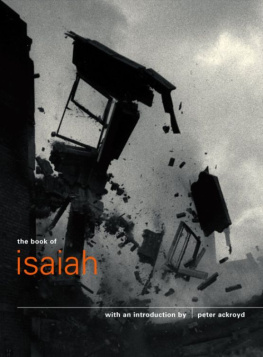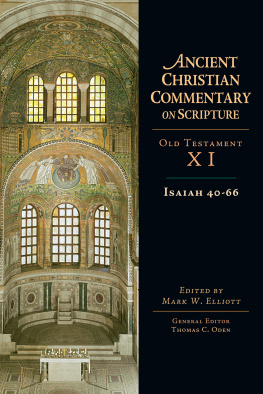2003 Victor L. Ludlow.
All rights reserved. No part of this book may be reproduced in any form or by any means without permission in writing from the publisher, Deseret Book Company, P.O. Box 30178, Salt Lake City Utah 84130. This work is not an official publication of The Church of Jesus Christ of Latter-day Saints. The views expressed herein are the responsibility of the author and do not necessarily represent the position of the Church or of Deseret Book. Deseret Book is a registered trademark of Deseret Book Company.
Library of Congress Cataloging-in-Publication Data
Ludlow, Victor L.
Unlocking Isaiah in the Book of Mormon / Victor L. Ludlow.
p. cm.
Includes bibliographical references and index.
ISBN 1-59038-170-X (alk. paper)
1. Bible. O.T. IsaiahCommentaries. 2. Book of Mormon. NephiCommentaries. I. Title.
BS1515.53.L84 2003
289.322dc22 2003015673
Printed in the United States of America 18961-0323R
R. R. Donnelley and Sons, Crawfordsville, IN
10 9 8 7 6 5 4 3 2

Acknowledgments
I should first thank the many students in my religion classes at BYU who have been frustrated with the Isaiah passages in the Book of Mormon. This book is to help them and their children as they read the Book of Mormon and want clearer understanding of the Isaiah material. I also have a personal interest in my grandchildren who will soon be reading the Book of Mormon. I do not want them to be discouraged with the wonderful Isaiah passages, and so this book is especially for them.
I particularly want to thank my wife, V-Ann, for her patience and support with this project. My children Jason, Jared, Sharryl, Shawnda, Daniel, and David and their spouses have also been encouraging and supportive.
My student secretary, Adrienne Landes, has helped in many ways with this project. Three BYU student research assistants have worked intensely with this manuscript during the past couple of years: Carli Anderson, Carolyn Deverich, and Melissa Rowe. And John Ericksen provided valuable help during the past few months. I thank them for their help and ideas and especially for their critical insights. The publishing staff at Deseret Book, especially Jack Lyon, have also provided valuable help.
I alone am responsible for the contents of this book. My hope is that it will help generations of Book of Mormon readers to more fully appreciate and understand the many chapters and verses of Isaiah which the Savior and His prophets Nephi, Jacob, Abinadi, Mormon, and Moroni cite in their sacred writings. The writings of Isaiah are profound, and the Book of Mormon provides the best insights into his powerful teachings and prophecies. Let us read and enjoy his words, especially as they apply to us in these latter days!
Chapter 1

Isaiah the Profound Prophet
The writings of Isaiah constitute the most important prophetic discourses of the Old Testament. Indeed, Isaiah is quoted more in the New Testament, the Book of Mormon, the Doctrine and Covenants, and the Dead Sea Scrolls than any other Old Testament prophet. Jesus quoted Isaiah extensively as he began His public ministry in Nazareth,
This book will help readers of the Book of Mormon understand the Isaiah passages found in 1 Nephi, 2 Nephi, Mosiah, and 3 Nephi. This first chapter highlights the historical setting and the prophetic role of Isaiah in biblical times. The next chapter reviews Isaiahs significance within the Book of Mormon and also provides some suggestions of how to study the Isaiah chapters in the Book of Mormon. The third chapter explains the poetic style used by Isaiah in his writings. The following chapters 4 through 23 present insights and prophetic commentary about the individual Isaiah chapters in the order in which they appear in the Book of Mormon. The concluding chapter summarizes the significance of Isaiahs words for Latter-day Saints.
Isaiahs life history
In spite of the comparatively large collection of Isaiahs writings, relatively little information was recorded about the man, his family, and his ministry. Isaiah was born around 775 b.c., approximately one century after the great prophet Elijahs ministry. He lived in Jerusalem, seems to have been well educated, was married, and had at least two sons and possibly one daughter. He served as the Lords prophet for almost fifty years before suffering a martyrs death.
Isaiah grew up during the reign of two ambitious Israelite kings. In the northern kingdom of Israel, King Jeroboam II beautified Samaria and expanded his countrys borders and influence to their greatest extent since Solomons time, some two centuries earlier. In the southern kingdom of Judah, King Uzziah served as Jerusalems most powerful king in more than a century. Wealth, social injustices, immorality, and growing pagan worship characterized both societies, but more so in the north. This was also a time of relative peace for both kingdoms since neither Assyria (to the northeast) nor Egypt (to the southwest) had strong rulers.
Shortly after Isaiah reached adulthood, the two Israelite kingdoms weakened as one of Assyrias most powerful kings, Tiglath-pileser III (or Pul, as he was called in the Bible), came to the throne in 745 b.c. Civil dissensions, rebel rulers, international warfare, and assassinations had disrupted the northern kingdom of Israel after Jeroboams death. Meanwhile in Judah, Uzziah had become a leper, social outcast, and co-regent king with his son after trying to burn the priestly incense in the temple. Both Israelite nations also became increasingly spiritually and morally corrupt. The prophet Hosea spoke of Israels broken covenants and especially warned her of wickedness and pending destruction. The prophet Amos chastised both nations for their neglect of the poor and needy. These prophets were preaching as Isaiah married and began his family.
Isaiah tells us very little concerning his family life. His two sons had symbolic names, Shear-jashub and Maher-shalal-hash-baz, both of which contained prophetic warnings (Isaiah 7:3; 8:1). Ancient Jewish tradition suggests that Isaiah was related to the royal families of Judah, and the scriptures record that his ministry spanned the reigns of four Judean kingsUzziah, Jotham, Ahaz, and Hezekiah (Isaiah 1:1). He received his prophetic call at the end of Uzziahs reign (about 740 b.c.) and served for almost half a century until the end of Hezekiahs reign. Jewish tradition also says that one of Isaiahs daughters married King Hezekiah. According to Josephus, a later Jewish historian, Isaiah suffered a martyrs death at the hands of the wicked King Manasseh, Hezekiahs son, who would have been Isaiahs grandson. Manasseh had Isaiah encased within a rotting tree trunk and sawn asunder with a wooden saw. This martyrdom would have occurred around 695 to 692 b.c. Thus, Isaiah completed his long prophetic ministry almost one century before Lehis family left Jerusalem.
Isaiah as a prophet
Isaiah was called as a prophet in the year that King Uzziah died, about 740 b.c., when he experienced a great vision concerning his call (2 Nephi 16/Isaiah 6). He was soon recognized by both kingdoms as a prophet of the Lord, although the people and their kings did not always heed his counsel. He was the last major prophet to teach all the Israelite peoples before they began to scatter from the Holy Land. His words went with them to the four corners of the earth to instruct, inspire, and comfort them throughout following generations. However, as his descendants and others study his messages today, they experience difficulty in comprehending his writings because of the varied and complex nature of his prophecies and poetry. As Nephi said of his brothers, They know not concerning the manner of prophesying among the Jews (2 Nephi 25:1). Because Isaiahs ancient culture was so drastically different from modern society, most readers also lack an understanding of Isaiahs terminology, symbolism, imagery, phraseology, and poetic style.

